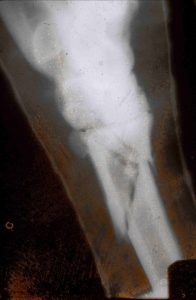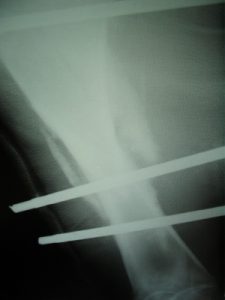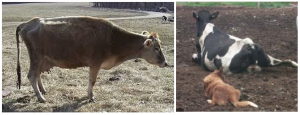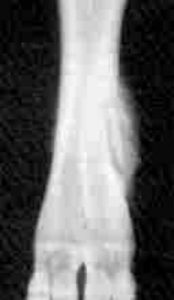Bovine musculoskeletal disorders
Adult fractures and luxations
Cannon bone fractures
These are high energy fractures and are often comminuted and open. Fixation requires full limb cast or transfixation cast. Prognosis is better in cattle than in horses but poor if the fractures are open and/or articular.

Radial and tibial fractures
Better prognosis in cattle than horses but these need a transfixation cast or external fixateur apparatus. A regular cast does not usually work unless the fracture is very distal on the radius. Internal fixation is great but often too costly.

Femoral fractures
We cannot fix these but they will often heal on their own as the musculature will stabilize it. Affected animals need good bedding and nursing care. The limb may end up with abnormal conformation.
Coxofemoral luxation
Caused by sudden hyperextension. These generally have a poor prognosis; referral is needed for therapy unless very acute (then try to manipulate back into the socket).
Luxations may be caudodorsal (animals can usually stand up) or cranioventral (animals are usually down).

Patellar luxation
Can be treated with imbrication but this is challenging in larger animals.
Sequestra
Devitalized bone fragments can develop after full thickness wounds. Debridement is needed to allow healing. Suspect sequestration if draining tracts persist.

Prognosis
Cattle are excellent patients and heal rapidly. This improves their prognosis over horses. However, fractures can heal misaligned due to the same forces. Example: cattle lie down frequently but the limb alignment is different when the animal is lying rather than standing.
In general prognosis decreases with these fracture components:
- articular fractures- these lead to arthritis
- comminuted fractures- it can be difficult to regain alignment and sequestration is possible
- open fractures- this is now a race between infection and healing
- eburnation – this is the rounding of the bone ends due to lack of stability early on
- poor blood supply – oxygen is necessary for healing
Prognosis also decreases with these factors
- lack of stability during healing- trying to use a splint vs a cast or a cast vs internal fixation
- distraction of bone ends – slight overriding of bone ends is good
- larger sized animals- our implants were designed for humans, not cattle
- less well behaved animals- more force, more likely to get motion
- high lactate on admission – maybe related to the blood supply?

